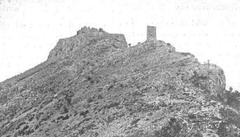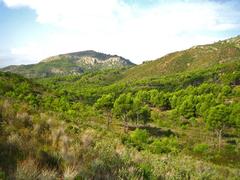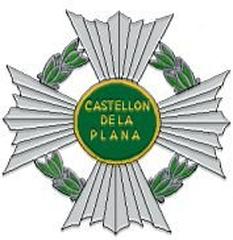Camí de la Cantera de Vora Riu Visiting Guide: Hours, Tickets, and Tips
Publication Date: 24/07/2024
Introduction: Discover the Charm of Camí de la Cantera de Vora Riu
The Camí de la Cantera de Vora Riu in Castelló de la Plana, Spain, offers an extraordinary journey through history, culture, and natural beauty. This historical path, which dates back to the 19th century, initially served as a connection between fishing villages along the rugged cliffs of the Mediterranean coastline. Over the years, it evolved to play a strategic role in police surveillance and border patrol during the early 20th century, combating smuggling activities along the Catalan coast (Otts World). Despite its decline in significance in the post-1950s era due to urban development, recent restoration efforts have revived the Camí de la Cantera de Vora Riu, transforming it into a scenic hiking trail that integrates historical exploration with modern outdoor adventure (GDTER).
This comprehensive guide aims to provide visitors with essential information on the history, cultural significance, and practical aspects of visiting the Camí de la Cantera de Vora Riu. From its origins as a vital footpath for fishermen to its modern-day role as part of the larger GR-92 trail, the Camí de la Cantera de Vora Riu stands as a testament to the dynamic history and rich heritage of Castelló de la Plana.
Table of Contents
- Introduction
- Historical Background of Camí de la Cantera de Vora Riu, Castelló de la Plana, Spain
- Visitor Information
- Special Events and Guided Tours
- Visuals and Media
- FAQ
- Conclusion
- Call to Action
Historical Background of Camí de la Cantera de Vora Riu, Castelló de la Plana, Spain
Origins and Early Use
The Camí de la Cantera de Vora Riu dates back to the 19th century. Initially, these small footpaths along the cliffs connected fishing villages, facilitating the movement of fishermen and villagers along the rugged coastline.
20th Century - Surveillance and Border Patrol
In the early to mid-1900s, the paths were utilized for police surveillance and border patrol to combat smuggling activities along the Catalan coast. The term “Ronda” in Camí de Ronda translates to “beat” or “patrol,” reflecting this period of heightened security (Otts World).
Decline and Urban Development
Post-1950s, the significance of these paths began to wane. Urban development and a decline in their use led to the gradual disappearance of many sections of the Camí de la Cantera de Vora Riu. The expansion of urban areas and infrastructure projects overshadowed the historical and practical importance of these routes (Otts World).
Modern Restoration Efforts
In recent years, there has been a concerted effort to restore and reinstate the Camí de la Cantera de Vora Riu. This initiative aims to reconnect modern-day villages and provide a scenic route along the Mediterranean coast of Catalonia. The restoration not only preserves the historical significance of these paths but also promotes tourism and outdoor activities (Otts World).
Cultural and Environmental Significance
The Camí de la Cantera de Vora Riu is not just a historical route but also a cultural and environmental treasure. The paths traverse diverse landscapes, including dense forests, cliffs, and coastal plains. These areas are home to a variety of flora and fauna, making the route an important ecological corridor. Restoration efforts also focus on protecting these natural habitats and promoting sustainable tourism (GDTER).
Key Historical Events
Several key historical events are associated with the Camí de la Cantera de Vora Riu. For instance, in 1953, a ship named Annie Braz was intercepted at the beach of Llafranc with smuggled goods valued at over $10,000. This incident highlights the strategic importance of these paths in combating illegal activities during that era (Camí de Ronda).
Integration with Modern Hiking Trails
Today, the Camí de la Cantera de Vora Riu is integrated into modern hiking trails, offering a blend of historical exploration and outdoor adventure. The paths are part of the larger GR-92 trail, which spans the Catalan coast. Hikers can experience the historical significance of the route while enjoying breathtaking coastal views and well-preserved natural landscapes (Lost and Abroad).
Notable Sections and Landmarks
Several sections of the Camí de la Cantera de Vora Riu are particularly notable for their historical and scenic value. For example, the stretch from Cala Margarida to Platja del Castell passes through ancient fishermen’s huts and offers views of the Castell de Sant Esteve de Mar. Another significant section is from Calella de Palafrugell to Tamariu, which includes the ancient Iberian settlement of Castell and the picturesque Cala Estreta (Viajando Nuestra Vida).
Visitor Information
Visiting Hours
The Camí de la Cantera de Vora Riu is open year-round, although specific sections may have restricted hours depending on the season and ongoing restoration work. It is recommended to check local information resources or official websites for the latest updates.
Tickets and Admission
Access to the Camí de la Cantera de Vora Riu is generally free. However, guided tours or special events may require a ticket. Information on these can be found through local tourism offices or official websites.
Travel Tips
For those planning to visit the Camí de la Cantera de Vora Riu, it is advisable to prepare adequately for the hike. The trail can be challenging in certain sections, with steep climbs and uneven terrain. Visitors should carry sufficient water, sunscreen, and appropriate hiking gear. Additionally, it is recommended to start early in the day to avoid the midday heat and to take advantage of the cooler morning temperatures (Lost and Abroad).
Nearby Attractions
While visiting the Camí de la Cantera de Vora Riu, consider exploring nearby attractions such as the Castell de Sant Esteve de Mar, the ancient Iberian settlement of Castell, and the picturesque beaches of Cala Estreta and Platja del Castell. These sites offer additional historical and scenic experiences, enriching your visit to the region.
Accessibility
Efforts are being made to improve accessibility along the Camí de la Cantera de Vora Riu. Some sections are more accessible than others, so it is advisable to plan your route in advance. Information on accessible paths can be obtained from local tourism offices or official websites.
Special Events and Guided Tours
Throughout the year, various special events and guided tours are offered along the Camí de la Cantera de Vora Riu. These provide unique opportunities to learn more about the history and significance of the area. Check local tourism resources for current event schedules and tour availability.
Visuals and Media
Incorporate high-quality images or videos of the Camí de la Cantera de Vora Riu. Ensure these are optimized for the web with correct sizing and alt tags containing keywords. Interactive elements such as virtual tours or maps can also enhance the visitor experience.
FAQ
What are the visiting hours for Camí de la Cantera de Vora Riu?
The path is open year-round, but specific sections may have restricted hours depending on the season and restoration work. Check local information resources or official websites for the latest updates.
Do I need a ticket to visit Camí de la Cantera de Vora Riu?
Access to the path is generally free, though guided tours or special events may require a ticket. Information on these can be found through local tourism offices or official websites.
What should I bring for a hike along Camí de la Cantera de Vora Riu?
Visitors should carry sufficient water, sunscreen, and appropriate hiking gear. It’s also recommended to start early to avoid midday heat.
Are there guided tours available?
Yes, guided tours are available and provide unique insights into the history and significance of the path. Check local tourism resources for current schedules and availability.
Conclusion
The Camí de la Cantera de Vora Riu is a testament to the rich historical and cultural heritage of Castelló de la Plana. Its transformation from a simple footpath to a strategic surveillance route and now a popular hiking trail reflects the dynamic history of the region. The ongoing restoration and preservation efforts ensure that this historical route remains a valuable asset for future generations to explore and appreciate.
Call to Action
Download the Audiala mobile app for more travel guides and updates. Follow us on social media for the latest news and tips on exploring historical sites like the Camí de la Cantera de Vora Riu.
References
- Otts World. (n.d.). Camino de Ronda Coastal Path Hike. Retrieved from Otts World
- GDTER. (2021). Camins Vora Riu. Retrieved from GDTER
- Camí de Ronda. (n.d.). Introduction. Retrieved from Camí de Ronda
- Lost and Abroad. (n.d.). A Guide to the Best Camino de Ronda Day Hikes Across Costa Brava. Retrieved from Lost and Abroad
- Viajando Nuestra Vida. (n.d.). Caminos de Ronda Costa Brava. Retrieved from Viajando Nuestra Vida




